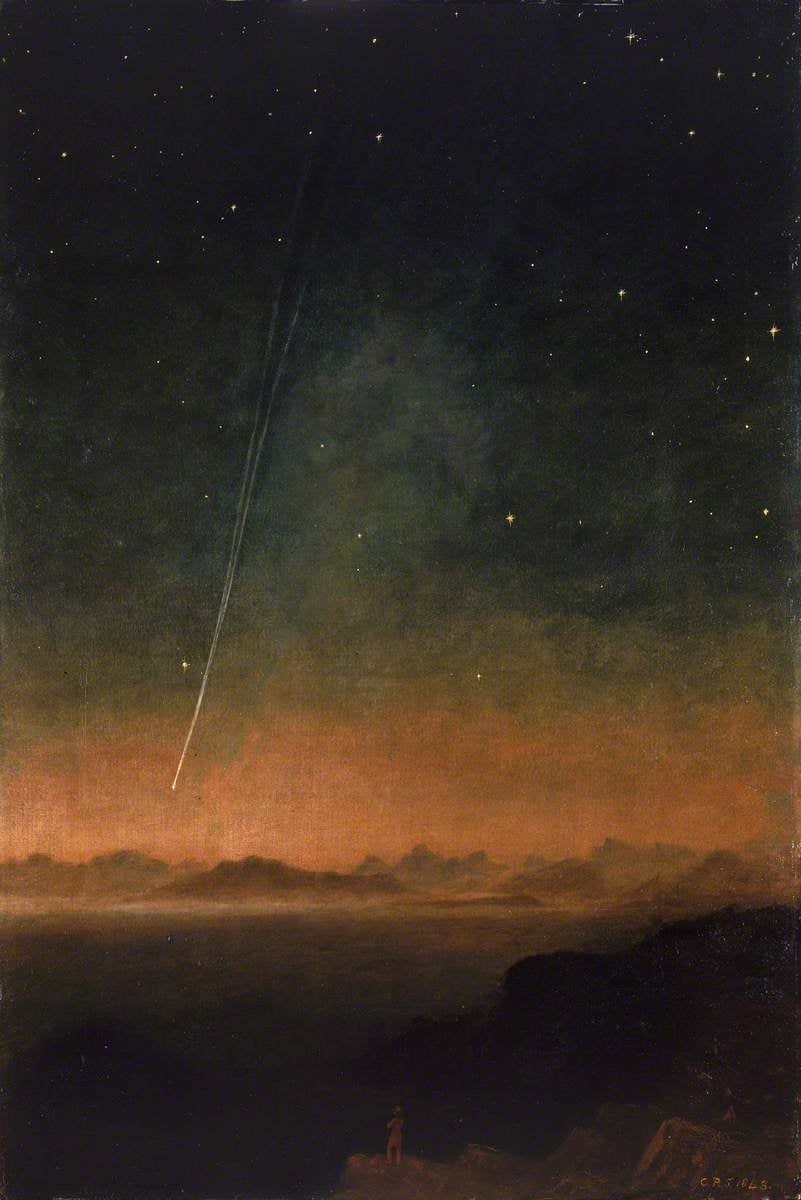Part One: A Luminous Streak
This is part one of a three part series on celestial events.
Looking to the night sky – with questions, for answers, in wonder – is something all humans do. While the moon and the stars have offered humans knowledge and mystery for millennia, we have often interpreted unexpected light and movement in the sky within the context of bigger changes underway on earth.
A Luminous Streak
In early March 1843, a small crew of Hudson’s Bay Company (HBC) employees began efforts to establish a trading fort on Vancouver Island. The Great March Comet, as it was also called, coincided with the company’s new start on the lands of the Lekwungen speaking peoples. As a new outpost of the British Empire took shape, the giant ball of ice and dust streaked the sky. The HBC’s James Douglas – future governor of the Colony of Vancouver Island – recorded the event in his personal diary for March 17th, 1843:
“Saw a luminous streak in the heavens this evening which lasted from dusk until 9 o’clock when the moon rose and obscured it. Its highest altitude was at Betelguix in Orion, due south from the position we occupied at the time of its appearance and extended from thence in a continuous line to the southwest point of the horizon forming an arc of about 90 degrees. At Betelguix its breadth was…arcs…and it diminished gradually towards the southwest horizon. We cannot account for this phenomenon unless we suppose it is produced by the reflection of the waters in the straits of Juan De Fuca, although it is difficult to account for its existence on any such principle. It was also seen last night.”
What Douglas “cannot account for” is possibly the 1843 comet’s double tail. The comet appeared to have two tails, a feature captured in paint by astronomer Charles Piazzi Smyth at the Royal Observatory, Cape of Good Hope, South Africa. He saw the comet on March 3rd and 6th, 1843.

With Douglas on this trip was Father Jean Baptiste Zacharie Bolduc, a Roman Catholic missionary. In the post script of a letter, Bolduc notes that he saw the comet as well. During his brief stay on Vancouver Island, Bolduc held religious services for HBC employees and local First Nations:
“On Sunday, more than twelve hundred Indians of three different nations, Kawaishins, Klalams, and Samishes [Cowichan, Klallam, and Songhees], were assembled around our modest temple. Our commander [James Douglas], a religious man, although a Protestant, arrived there as well as some Canadians…”
Although the comet was an afterthought in Father Bolduc’s letter (quite literally), it seems reasonable to expect that it featured in his proselytizations about the “...existence of God, the creator of all things, who rewards good actions and punishes the bad by eternal chastisement.” If the heavens are the domain of Bolduc’s god and creator, such a spectacular event may have helped him illustrate this point.
In another letter from 1842, Bolduc described his joy at seeing the stars during his sea voyage to the Pacific Northwest:
“...raising the eyes toward the firmament, the clearness of which is not obstructed by any mist, what richness, what a multitude of stars is displayed to one who knows how to contemplate it all with a religious heart. One admires each new sight and wishes never to cease admiring it…Then it is that one enjoys, with the least effort, the knowing of not only the first elements of astronomical science but also the construction of the constellations, their relationships, the knowledge about the planets, their progress, their changes. For if the contemplation of the firmament is at all satisfying to one who does not understand its beauty, how ravishing it can be for him who has some idea of its perfection! “
In this excerpt, Bolduc reflects on his scientific knowledge with “a religious heart.” Both Bolduc and Douglas had enough knowledge of astronomy to know they were looking at a comet; it may not have been sent by god, but it was passing through god’s creation.
What Bolduc did not know is that the location of the stars and the moon have guided First Nations cultural practices and movements since time immemorial. Around the Salish Sea, a number of First Nations tell creation stories which speak of people falling from the sky.
Each person who gazed up on the “luminous streak” over March and April 1843 likely attributed their own meaning to it or found that it reinforced their own worldview. Today, we know that the construction of a fort at the southern end of Vancouver Island commenced a new era of trade and colonization. That this construction coincided with the arrival of a double tail comet is either something sacred, something ominous, or simply a coincidence – depending on how you look at it.
NEXT WEEK:
Part Two: A mysterious red star moves erratically across the sky, alarming residents of Victoria and Vancouver. Was this some kind of new airship or a visitor from beyond the earth….?